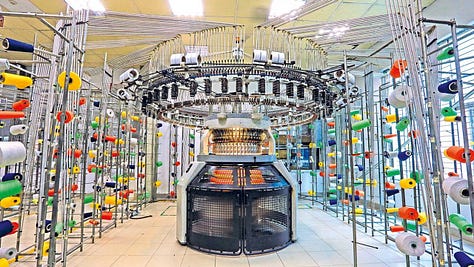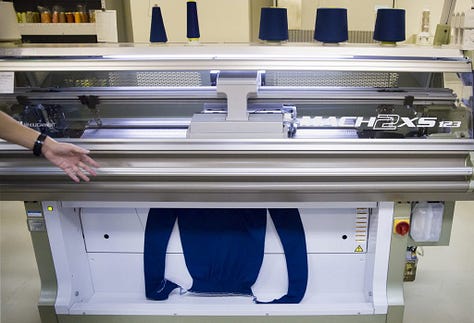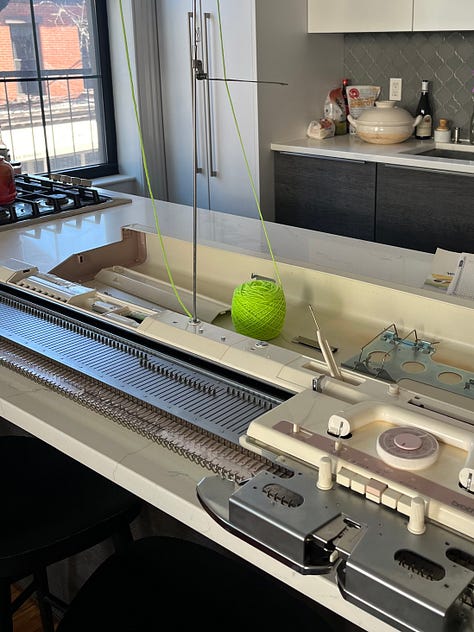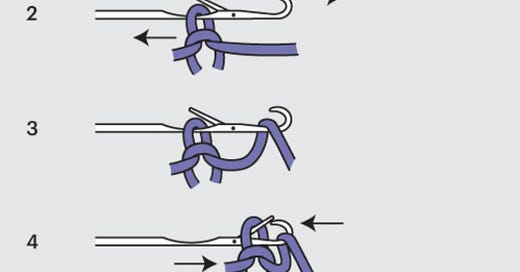🧶 Knitting Journey - Retro & Intro to Machine Knitting
Hey all,
After finishing my sweater, I did a little ‘retrospective’ exercise to organize my thoughts (next time I’ll use sticky notes so I can share a good photo). Some questions that stood out to me:
What qualifies a good candidate for unraveling / re-knitting? More on this in a future week...
How can I make this easier/faster? More on this below…
I’ve been calling this sweater the ‘v0’ sweater because I consider it a proof of concept. It demonstrates that it’s possible to knit a sweater out of ‘waste’ materials and transform them into a compelling (higher value) end product. But at 50+ hours of work on one sweater, this project will never scale beyond a hobby!
So I started to explore the question “Can I get to the same outcome 10x faster”…? Which brought me to machine knitting.
What exactly is machine knitting?
Per Wikipedia, “a knitting machine is a device used to create knitted fabrics in a semi or fully-automated fashion”. Most friends I’ve talked to have never heard of machine knitting - which isn’t surprising because it’s a niche hobby (it’s a lot less popular than hand knitting). And, we’re pretty out of touch with how our clothes are made. Every single T-shirt you’ve ever owned came from a knitting machine!
Most fabrics fall into two categories: wovens and knits. Two sets of yarn are interlaced to create woven fabrics (left), while one strand of yarn is interlooped to form knit fabrics (right).
Woven fabric is typically used to make button-down shirts and jeans, while T-shirts are usually made of knit fabric. If you look really closely at your T-shirt (or sweater, or hoodie) you can see tiny columns of loops.
Knitting machines produce knit fabrics. At scale, these machines are completely automated and produce tubes of knit fabric (automated looms produce flat sheets of woven fabric), that get cut and sewn into clothes. There’s also a new category of machine knitting called 3D knitting - we’ll deep dive on that another day. Finally, there’s a category of flat-bed knitting machines designed for smaller scale production and hobbyists. They were (somewhat) popular for home use in the 80s but have since fallen out of fashion (ha). You’re probably wondering what these machines look like:



And they all share the same fundamental technology, an array of latched needles that extend to catch yarn and retract to pull that yarn through the previous loop.
In January I took a class at the Textile Arts Center here in Brooklyn to learn the basics, and last week I bought a machine on eBay . I can already see the potential for speeding up my production time. I know that sourcing and unraveling will quickly become the biggest bottleneck - I figure that speeding up the knitting process will free up time to work on better solutions for those processes.
Over the next 3 weeks, I’ll write about another design <> materials <> manufacturing cycle as I knit another ‘waste’ sweater, this time on a knitting machine - and I promise to include videos! I’ll call this a ‘v1’ as I build on my proof of concept and aim to uncover new insights and pain points along the way. Hope you find this series interesting and always happy to hear your questions and feedback!
Best,
Anne





